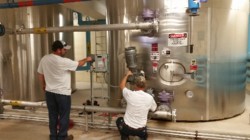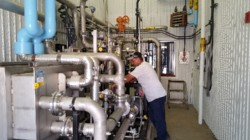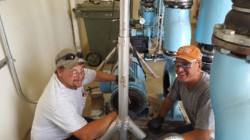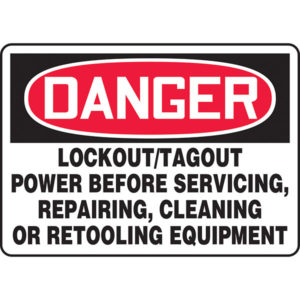 Safety and Environmental Protection
Safety and Environmental Protection
Wastewater treatment plants have a direct impact on public health. It is the responsibility of the maintenance group to ensure that sensors, meters, and recorders function so that they can provide accurate data to the operators. This information is used to adjust plant processes to ensure that the public is protected.
 One of many roles of the Maintenance group is to maintain pumps, boilers, compressors, methane engine and other various pieces of equipment at the treatment facility. We also maintain 17 sanitary lift stations and 22 storm water stations located throughout the City of Fond du Lac. We prevent leaks, overflows and control odors to achieve the quality of wastewater treatment that can be discharged into Lake Winnebago.
One of many roles of the Maintenance group is to maintain pumps, boilers, compressors, methane engine and other various pieces of equipment at the treatment facility. We also maintain 17 sanitary lift stations and 22 storm water stations located throughout the City of Fond du Lac. We prevent leaks, overflows and control odors to achieve the quality of wastewater treatment that can be discharged into Lake Winnebago.
Maintenance is a support function providing a cohesive process that assists Operations and Lab personnel in fulfilling the mission of the facility. This is achieved by ensuring that the equipment is operating at an expected level of reliability at any given time and within a specified budget. Our goal is to have the equipment reach or go beyond its life cycle.

Wastewater treatment plants require maintenance to prevent leaks, overflows and odors, and to achieve the quality of wastewater treatment and the release limits required by the operators EPA or local council license. The Fond du Lac Wastewater Resource & Recovery Facility has developed a centralized operation, maintenance and management system for our treatment plant.

As soon as a facility is put into service you will soon see a predicable decline in condition and efficacy. Meaning, buildings and roofs have about 25-30 years before major work is required. It is our job to make the inspections to ensure getting maximum life. The same goes for equipment, the only difference being that the preventive maintenance starts as soon as the equipment is put into service. The equipment life cycle is closer to plus/minus 15 years.

The steps in maintenance include a periodic review of a schedule to determine what tasks should be conducted on a system, regular review of expendable items to ensure sufficient supplies are on hand or ordered, issuing work orders or scheduling tasks to accomplish maintenance, review of the completed task, modification of the preventive maintenance (PM) schedule, if necessary and budget management.
Maintenance identifies and remedies potential problems before they impact the operation of the plant and lift stations. This requires establishment of a set of preventive maintenance parameters to:
- Reduces the potential for unexpected equipment shutdowns.
- Promotes a schedule of downtime whenever possible.
- Assures the reliability of the system to maintain treatment standards.
- Reduce overall costs by correcting minor problems before they become major.
- Provide data on the usable service life of equipment and provide a replacement schedule.
- Keep an accurate and up to date data base on the present equipment.
Treating wastewater has a direct impact on public health and safety. Maintenance ensures that sensors, meters and recorders are working properly to ensure accurate data is collected by operations. This data is used to adjust plant processes to ensure the general public is safe.

All Maintenance, Operations and Lab staff are trained in the following: Confined Space, First Aid, CPR and AED. By using the proactive approach we can ensure a level of service that ensures maximum operating efficiency.
Good practice also extends to the actual service and maintenance of the equipment. Injuries to plant personnel result when people work without thinking through the tasks or they accept risks that are not necessary. One way to minimize hazards include using lockout-tagout procedures to prevent accidental usage of equipment.

